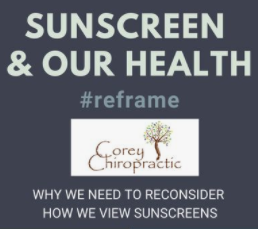
It’s June! You know what that means… beach vacations, backyard BBQs and pool parties!!! Most of us look forward to this time of year and all the warm sunny weather that it brings. But if this describes you, chances are at any given minute you are armed with a sunscreen that boasts a hefty SPF. How can I blame you when the mainstream media and all the big box stores have told you for years that you need to slather this stuff on any time you go into the warm summer sun? Don’t be alarmed, but these sources are notorious for not telling the whole truth about sunscreen. So, let’s chat.
“After decades of public health education, almost anyone who is heading outdoors has heard the message that sunscreen is an important part of protecting skin from sunburns, aging, and skin cancer. In fact, sun care is a nearly $2 billion-a-year industry in the U.S.” This is according to an article that WebMD put out in January of this year. New FDA testing shows that six of the most common ingredients found in leading sunscreens (avobenzone, oxybenzone, octocrylene, homosalate, octisalate, and ecamsule) are absorbed directly into our bloodstreams and may linger for a period of days up to weeks. Some of these ingredients are known to disrupt hormones and may lead to fertility issues, unsafe birth outcomes for infants and possibly even cancer.
It’s important to remember that sunscreen has been around for a very long time. Many health experts agree that it essentially got grandfathered into the FDA’s surveillance system without any real safety testing. That is why we’re doing more testing now. Of the six common ingredients mentioned earlier, four of them (avobenzone, oxybenzone, octocrylene, and ecamsule) were recently found to be absorbed into our bodies in substantial amounts. The same study that gave us this information also showed that blood concentrations of oxybenzone in people who used chemical sunscreen were more than 180 times the FDA’s level of concern after just a single application. Separate FDA research has shown that this rate of chemical absorption can have potentially toxic ramifications such as altered breast development, infant birth weight, and sperm function. A healthier alternative to these chemical sunscreens is something called “mineral sunscreen.” Mineral-based sunscreens use physical blockers such as zinc oxide and/or titanium dioxide which form an actual barrier on your skin and reflect the UV rays. They offer no harmful chemicals that can be absorbed into our bloodstream.
While I am not telling you to stop using chemical sunscreen, I’m letting you know that the benefits do not appear to outweigh the associated risks at this time. Another possibility I’d like you to consider is that perhaps sun exposure is not the enemy here. I passionately believe that our personal quality of health directly impacts how sun exposure affects us individually. For example, the higher the level of toxins we have in our bodies, the more prone to sun damage that we will be. Let me go out on a limb here and put it in these terms: I believe that it’s not the sun that gives us cancer, it’s the sun’s interaction with our unique body chemistry that may compromise us in the long run. This is just another one of the multitude of reasons to pay closer attention to your health.
Let us also remember that moderate sun exposure has benefits, too. Sunlight cues special areas in the retina, which trigger the release of serotonin (the key hormone that stabilizes our mood, feelings of well-being, and happiness). This means that sunlight is a natural anti-depressant. Healthline.com notes that getting five to fifteen minutes of sunlight on your arms, hands and face two to three times a week is enough to enjoy the vitamin D-boosting benefits of the sun. Vitamin D from sun exposure plays a key role in our bone health and can help ward off conditions like osteoporosis and osteomalacia. And although excessive sunlight can contribute to some skin cancers, a moderate amount of sunlight actually has preventive benefits when it comes to other forms of cancer. According to researchers at the Clinical Journal of American Society of Nephrology, those who live in areas with fewer daylight hours are more likely to have some specific cancers than those who live where there’s more sun during the day. These cancers include:
In summary, the sun is not our enemy. Sunscreens that are heavily concentrated with chemicals such as oxybenzone, avobenzone, octocrylene, and ecamsule have potentially toxic risks since these chemicals are absorbed by our bodies in significant amounts and tend to linger. By contrast, mineral sunscreens simply sit on top of our skin and reflect UV rays away from our bodies and are, therefore, a safer alternative. The healthier you are, the less likely that the sun’s interaction with your personal body chemistry will be harmful. And lastly, moderate responsible sun exposure can have some great benefits. These include boosted levels of serotonin and Vitamin D and possibly some preventive characteristics when it comes to certain forms of cancer.
So do your detoxification cleanses, grab your shades and mineral sunscreen and go enjoy your summer!!!

References:
-WebMD.com (skin problems and treatments)
-MedicalXpress.com (sunscreen chemicals and bloodstream)
-Healthline.com (sunlight benefits)
-Shape.com (mineral sunscreens, natural alternatives)